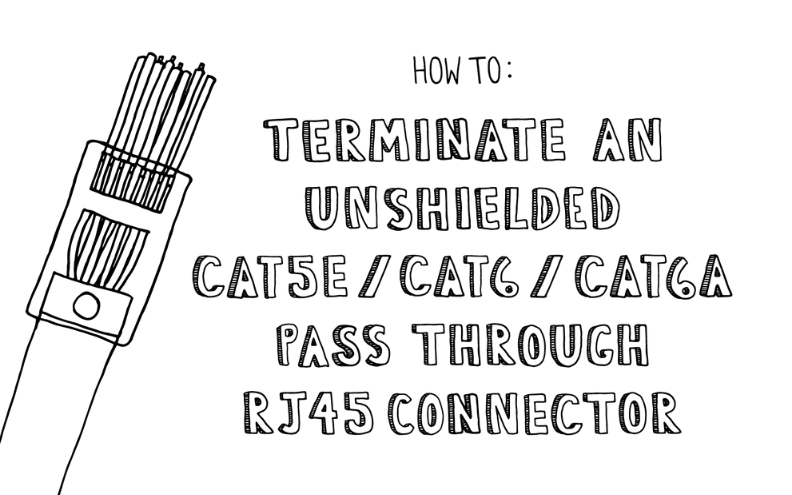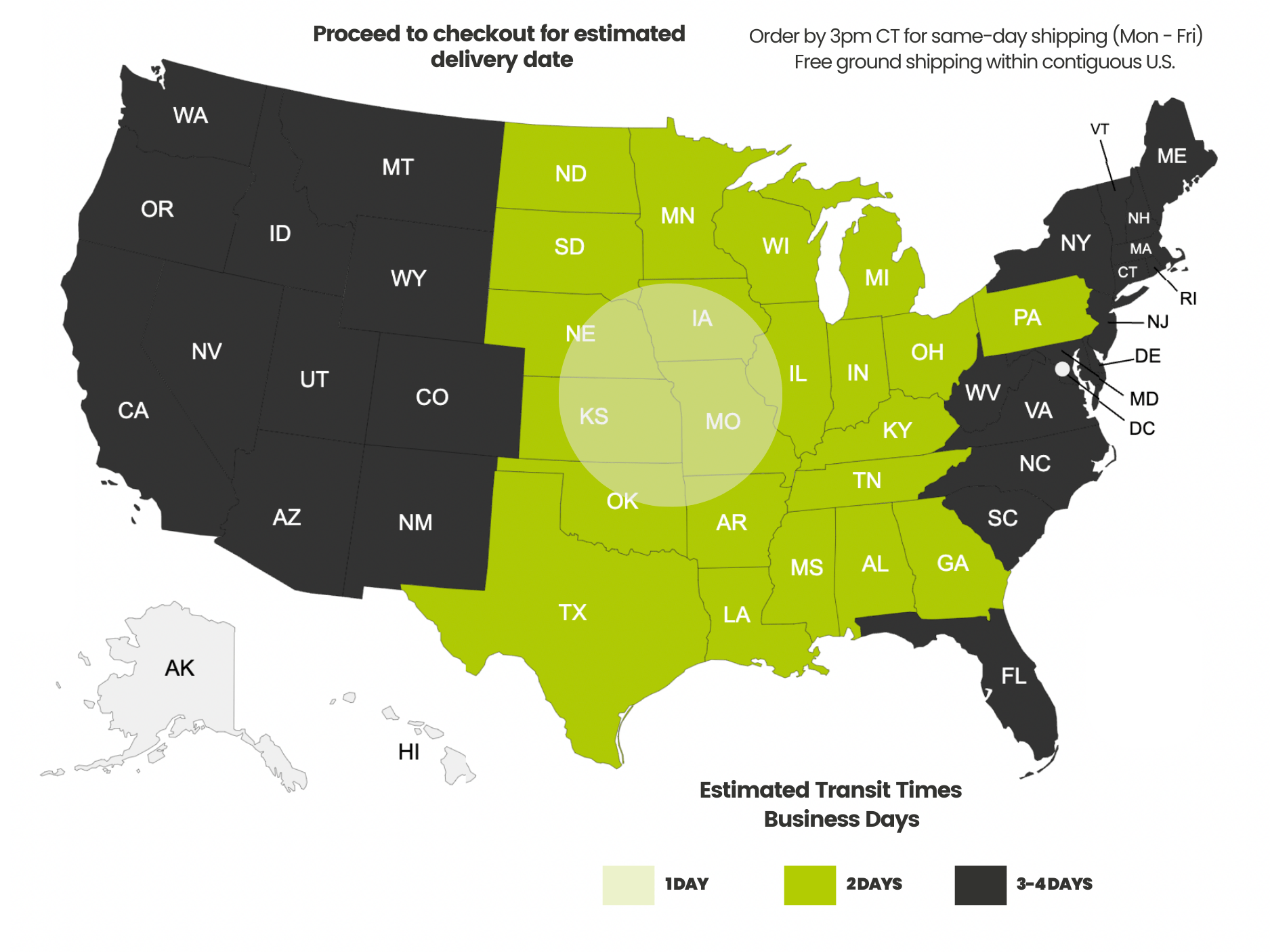Payment methods accepted

How To: Terminate an Unshielded Pass Through RJ45 Connector
Written by Don Schultz, trueCABLE Senior Technical Advisor, Fluke Networks Copper/Fiber CCTT, BICSI INST1, INSTC, INSTF Certified
Bulk unshielded Ethernet cable needs to be terminated. Wow! That sounds serious. No, we are not advocating hunting down all bulk unshielded Ethernet cable and doing it in. Ethernet cable termination means to attach something to the raw end of the cable so it can be plugged into something else like a switch or computer.
Ethernet cable termination is accomplished several ways either using keystone jacks or RJ45 connector plugs. One common way is “rack to jack”, which means from a central patch panel to keystone jacks mounted in your walls. This method is used by professional installers. All permanent cabling is hidden inside your walls. That would be the “perfect world” example. Well, we don’t live in a perfect world.
Sometimes terminating a RJ45 connector plug is the only way to accomplish your termination. A patch panel to an outdoor PoE WiFi access point or IP surveillance camera is at the top of the list. Perhaps for your installation using RJ45 plugs is the most straightforward way and what you are comfortable with; not everyone is able to mount a patch panel and then mount keystone jacks inside their walls. What if you need to make a custom length patch cable?
Regardless of why you are using RJ45 connector plugs, it is critical to pass along the correct method for success. With that in mind we will focus on the quickest, easiest, and most common do-it-yourself way...the pass-through unshielded RJ45 plug. Let’s take a dive
In addition to this written blog we provide a detailed video demonstration. Please take the time to watch the video and read the blog fully. Ask us if you have any questions. We want you to be successful!
Categorically Confusing
When talking about RJ45 plugs, you probably noticed quite the variety while shopping. I do a thorough job explaining all the different kinds of RJ45 (8P8C) connectors in What is an RJ45 Connector? I go even further in Selecting the Correct Connector. I suggest giving them a read when you get time. You will learn more than what 99% of people think they know from just two quick reads.
Here are the take-away facts:
- Category does NOT matter when selecting a RJ45 connector unless the manufacturer makes the RJ45 plugs, cable, and all other accessories and has tested them together
- Given the above statement, Category is still technically irrelevant. Fitment is what matters.
- A “Cat6” RJ45 plug from one manufacturer is not guaranteed to fit and work with a Cat6 termination or ethernet cable from another manufacturer and probably won’t. In fact, unless the manufacturer took the extra step to test everything together it is possible to buy it all from the same manufacturer and still have it all not work. How is that for a kick in the teeth?
In this blog, we are specifically talking about pass-through style unshielded connectors, so we will keep it to those while ignoring other options.
RJ45’s or 8P8C connectors are referred to as plugs, ends, and even crystals. They all mean the same thing.
Selecting the Right Unshielded Pass-Through RJ45 for You (with a bonus)
trueCABLE sells three types of unshielded pass-through RJ45 connectors:
This fitment table will help you select the right trueCABLE products quickly. In addition, cable strain relief boots are important for stabilizing the electrical contact of the ethernet cable termination. The weakest link of any Ethernet cable is the terminations. Use strain relief boots whenever you can, as you will need every advantage you can get.

For this demonstration, I selected Cat6A Unshielded Riser:
- The Cat6/6A Unshielded Pass-through RJ45 Plug is the correct connector
- The Medium Slip-On Strain Relief Boot is the correct boot for the cable
Required Tools
- Cable cutter of some kind (even electrician’s scissors are good for this)
- Tool for terminating RJ45 (we suggest ours as it has a built-in self adjusting cable stripper)
- Flush cutters
All-In-One Crimp & Termination Tool plus flush cutters

For trueCABLE Cat5e Unshielded Riser and Cat5e Unshielded Plenum, the self adjusting cable stripper found on the trueCABLE all-in-one crimp & ethernet cable termination tool will not work. You will need a separate cable stripper such as our Cable Cutting & Stripping Tool.
Additional Helpful Tools

Light gloves and a metal dowel or screwdriver shaft will save your fingers!
Are You an A or B?
The next step is deciding whether you want to use the T568A or T568B pattern. It does not matter which one you pick, as long as you stick with it. I prefer the “B” pattern, but that is just me. (If you want to make a more educated guess you can read more on the differences)

Gather Up the Tools, Here We Go!
From here on out, I’ll let the pictures speak for themselves with a bit of additional guidance...
Slide the strain relief boot down the cable before anything else! Then strip off about 2” of cable jacket

The idea is to score the cable jacket, but not cut through it. If you cut through the jacket, you risk nicking a conductor. You will need to start over if you nicked one!

Scored, but not cut! “Popping” the cable jacket. Bend a couple of times at the score to get it to pop.

After removing the cable jacket, do not throw it away yet. It will be used to untwist the conductor pairs.

Flush cut off the rip cord and any tape such as PE tape or waterproof fabric
Once this has been done, splay the conductor pairs into a “star pattern”.

Spline removal. Once all spline wings have been cut, twist to remove the spline

Skip this step for Cat5e. Splines are not present in Cat5e Ethernet cable. Splines may or may not be present in Cat6 termination. Splines are almost always present in Cat6A Ethernet cable.

Using the piece of cable jacket, untwist the pairs.

All pairs untwisted & begin to straighten. Easy does it. Practice will make perfect.
You want the conductors as straight as possible, and it may take two to three passes from the end of the cable jacket to the end of the conductor in order to accomplish this. Work on one at a time. Don’t use so much pressure that you break the conductors!
 This is what you are after. T568B sequence shown.
This is what you are after. T568B sequence shown.
Put your conductors into sequence. This is where you will play around lining up the conductors. The spline inside the cable jacket will fight you every step of the way. Work with the spline as much as possible. For any Ethernet cable that has a spline, this step in particular requires patience and practice. The goal is to minimize conductor cross over while maintaining the T568B (in my case) sequence.

Now flush cut the conductors straight across. My finger/thumb is out of the way for clarity. Normally you would keep the conductors in sequence with our finger/thumb while flush cutting.

Pick a good spot to flush cut! The smoother the spot you pick to flush cut, the easier getting the plug on will be. Keep the conductors lined up at all costs during this process.
Time for terminating the RJ45 plug. I use the “bottom” side of the plug (opposite side from the retaining latch) as my reference point. If you decide to use the “top” part of the plug, you will need to know your color sequence in reverse order and be able to see through the plastic latch. It is easier to do it from the bottom side.

Check the conductor sequence again at the plug front before fulling seating
Once you are satisfied the color sequence is correct, use a push and pull method to pull through the conductors and push the cable jacket upward as well. The idea is to get the cable jacket up into the rear of the plug as far as possible and to not have kinked up conductors inside the plug.

Standard depth ethernet cable termination. This is at the 1/2” maximum untwist allowable per ANSI/TIA 568 2.D. The termination on the right will provide more headroom. Strive for this when working with Cat6A.

Due to internal ramps inside the Cat5e pass-through RJ45 plug, the best ethernet cable termination permitted is the standard 1/2” untwist maximum. You cannot get the jacket seated deeper. This will not hurt performance.
Grab your RJ45 crimp and termination tool. Place the plug into the tool (it will only go one way) and make sure the conductors sticking out of the nose clear the cutting blade on the other side of the tool. Make sure the plug is fully seated, but do not force it as you may shave off plastic from the nose of the plug. At the same time, press the lever downward in one smooth motion.

Place cable and plug into the crimp tool, making sure the plug is fully seated. Handle down and cycle complete.
This single step does three things:
- Terminates the metal prongs to the conductors
- Pushes the strain latch at the rear of the plug into the cable jacket to hold it securely
- Shaves off the conductor excess
The final step is to take the plug and cable out of the tool and inspect your work. Make sure the eight golden contacts are fully down and none are popped up. If any are popped up, your ethernet cable termination is bad. Try retermination with the tool again. If that does not work, you will have to cut the plug off and start over. It happens.

Strain latch fully engaged. That is what keeps the cable from pulling out. All golden contacts fully seated. Conductors fully flush cut off. This is a good termination.
Time to Give it the Boot!

Slide the strain-relief boot up the cable…and over the plug housing
The Final Step
Once you have terminated both ends of your cable run, it is time for testing. There are a number of tools to accomplish this, and the easier and more informative the test is, the more expensive it will be. Take a look at this blog for tips on dealing with issues: Basic Network Cable Troubleshooting: What Did I Do Wrong?
There it is. Pretty easy to do, once you have a couple goes at it. Keep in mind that terminating an RJ45 plug is part science and part art. If you are new to this, practice on scrap cable and buy enough plugs just in case you make bad terminations. Trust me, I have made my fair share of bad terminations over the years before knowing how to terminate RJ45 connectors. Practice makes perfect.
HAPPY NETWORKING!
trueCABLE presents the information on our website, including the “Cable Academy” blog and live chat support, as a service to our customers and other visitors to our website subject to our website terms and conditions. While the information on this website is about data networking and electrical issues, it is not professional advice and any reliance on such material is at your own risk.






























I am trying to figure out my tool Cat 5E. I can terminate braid pair but when I try to terminate sold pair the tool does no engage into the metal. Before I buy a tool I wanted to know if this the case for all crimper or just the cheap one I bought.
Louis – Thanks for reading our blog! The problem is not with the termination tool you have but in fact the plug and cable combination. The first thing is to be sure the RJ45 plus is “3 prong”. Three prong plugs are designed to work with stranded AND solid copper conductors. Two prong plugs only work with stranded. The next item to check for is the specs on the plug and cable itself. You need to know if the insulated conductor diameter of the Ethernet cable is dimensionally compatible with your plugs. If your plugs and/or Ethernet cable is not fully documented to allow for a determination to be made, then I suggest switching brands (this is very critical and need to know information that should be easy to obtain).